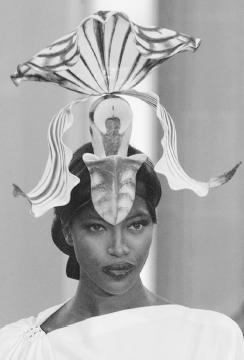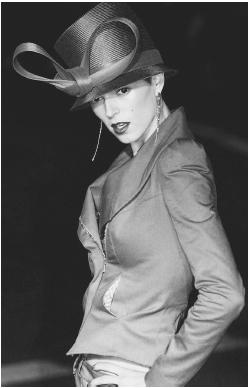Philip Treacy - Fashion Designer Encyclopedia
Irish designer working in London
Born: County Galway, Ireland, 1967. Education: Attended National College of Art and Design, Dublin, 1985-87; Royal College of Art, 1988-90. Career: Hat designer; worked with John Galliano and Rifat Ozbek, 1989; opened showroom in London, 1991; began working with Karl Lagerfeld and Chanel, from 1991; began designing diffusion line for Debenhams, 1992; shows sponsored by Harvey Nichols, Debenhams, Rolls Royce, British Fashion Council, Swarovski Crystal, Max Factor, and others, 1993-98; launched accessories line, 1997; participated in British Invasion at Saks Fifth Avenue, 1998; showings in Singapore and Vienna, 1999; moved to 12 Elizabeth Street, 1999; Paris couture week appearance, 2000; signed with

Publications
On TREACY:
Articles
Fallon, James, "Philip Treacy: The Shape of Things to Come," in WWD, 6 July 1990.
Killen, Mary, "Hats Off to Philip Treacy—His Fanciful Designs are Turning Heads," in Vogue, October 1991.
"Treacy: Another Feature at BG," in WWD, 15 November 1991.
McKenna, Joe, "The Big Fat Hat," in Interview (New York), November 1991.
Overland, Martha Ann, "Style Makers: Philip Treacy," in the New York Times, 5 April 1992.
Bowles, Hamish, "The New Enlightenment," in Vogue, March 1993.
Moore, Alison, "London Calling," in the New York Times Magazine, 19 December 1993.
"Glad Hatter," in People, 4 July 1994.
Luscombe, Belinda, "Mad About Hats: Milliner Philip Treacy's Fantastic Creations are Real Head Turners," in Time, 1 March 1999.
Fallon, James, "Treacy's Hat Show is Going Couture," in WWD, 13 December 1999.
Armstrong, Lisa, "The Mad Hatter of London," in the Times (London), 10 January 2000.
"Closing Remarks: Spring Couture Season Came to a Close With a Dazzling Show by Milliner Philip Treacy…" in WWD, 20 January 2000.
"Classic Beauty or Divine Madness," in WWD, 12 July 2001.
***
Former Royal College of Art student Philip Treacy was recognized as a talented milliner even before graduating from college where his final show was sponsored by Harper's & Queen magazine, London. In the years since leaving college, the Irish-born Treacy has moved to the forefront of the fashion world, producing hats for some of the most prestigious couture and ready-to-wear designers, including Chanel, Versace, Givenchy, Valentino, and Rifat Ozbek. Described as the Rembrandt of millinery by established hat designer, Shirley Hex, Treacy's monumental creations for the fashion catwalks often receive as much publicity as the outfits for which they were designed.
Treacy's millinery designs reflect his unquestionably vivid imagination, drawing upon diverse subjects such as surrealism, the dance of Martha Graham, or religious and historical imagery. Creating a hat, Treacy asserts, does not require space age influences; he prefers to plunder the past for inspiration and then make it appear totally new. A floral Treacy hat is a crash helmet covered in flowers and butterflies; a towering turban is created by an intricately wrapped blanket with fringed edging; a large cluster of black coq feathers are tied together with white feathers to form a brim and crown.
Treacy's hats, like those of other British milliners, are often described as eccentric. The designer attributes this eccentricity to the British being associated with idiosyncrasy, but says he does not set out to create deliberately unusual hats. Using what he describes as "boring" fabrics, Treacy begins working upon these materials with different treatments—feathers, for example, are singed so they take on the appearance of very fine gossamer.
An important factor in Treacy's work is his mastery of highly skilled traditional millinery techniques which ensure the correct balance, fit, and proportion for the hat which he concedes are as much mathematical as aesthetic. It is this artisan approach, with the emphasis on craft and technique, that characterizes much of Treacy's work. He produces hats for many different companies, both couture houses and ready-to-wear firms, and his annual shows in London and New York have been sponsored by a who's who of fashion and business, from Debenhams and Rolls Royce to Swarvorski Crystal and Max Factor. Treacy's ability to work at all levels of the market, from the

While Treacy's use of imagery and visual effects for his millinery creations is a vital element in his success, fashion critic Brenda Polan claims Treacy's mastery of technique is what singles him out as a great milliner, stating, "The balance of his hats, their swooping and curving, is perfect. A Treacy hat sits naturally upon the head, its proportions complementing those of the body, its horizontal and vertical lines extending and dramatizing the planes of the face. It is a perfection only an obsessive can achieve."
Obsessive or not, Treacy creations are unique and in demand. The designer branched out into accessories in 1997, and in 1999 was asked by the Federation Françoise de la Couture to show his hats during the spring-summer haute couture presentations. Treacy, honored and excited by the prospect, put together a small, specialized collection, telling Women's Wear Daily (13 December 1999) "I can't compete with the multizillionaire designer companies, so I plan to do a very small, discreet collection…. It's important to give a profile to hat making; hats and headdress have been around since the beginning of time, despite the fact that many people say hats are finished."
Response to Treacy's highly anticipated catwalk collection were enthusiastic, with Women's Wear Daily (20 January 2000) declaring, "Treacy's hats were sculptural, exquisite…. This season, he's fallen head over heels for orchids, and he delivered a hothouse full of exotic hand-painted blooms that were fabulous." Succeeding shows continued to be the rage for critics and fellow designers alike, placing Treacy firmly in the upper echelons of fashion royalty. His aim, however, is simple—"The object of the exercise is to beautify women," Treacy had explained to Women's Wear Daily (20 January 2000). "I want to inspire young people to wear hats and to think of hats as something new and modern. In our parents' generation, to wear a hat used to be to conform. Now, to wear a hat is to rebel." Well said by the master.
—Catherine Woram
Sydonie Benét
Comment about this article, ask questions, or add new information about this topic: